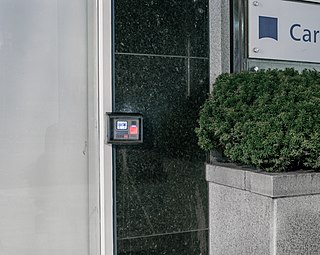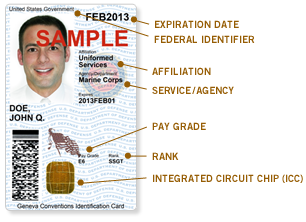
In physical security and information security, access control (AC) is the selective restriction of access to a place or other resource, while access management describes the process. The act of accessing may mean consuming, entering, or using. Permission to access a resource is called authorization.

Physical security describes security measures that are designed to deny unauthorized access to facilities, equipment, and resources and to protect personnel and property from damage or harm. Physical security involves the use of multiple layers of interdependent systems that can include CCTV surveillance, security guards, protective barriers, locks, access control, perimeter intrusion detection, deterrent systems, fire protection, and other systems designed to protect persons and property.

A proximity card or prox card also known as a key card or keycard is a contactless smart card which can be read without inserting it into a reader device, as required by earlier magnetic stripe cards such as credit cards and contact type smart cards. The proximity cards are part of the contactless card technologies. Held near an electronic reader for a moment they enable the identification of an encoded number. The reader usually produces a beep or other sound to indicate the card has been read.

A lock is a mechanical or electronic fastening device that is released by a physical object, by supplying secret information, by a combination thereof, or it may only be able to be opened from one side, such as a door chain.

A time clock, sometimes known as a clock card machine or punch clock or time recorder, is a device that records start and end times for hourly employees at a place of business.

A security token is a peripheral device used to gain access to an electronically restricted resource. The token is used in addition to, or in place of, a password. Examples of security tokens include wireless keycards used to open locked doors, a banking token used as a digital authenticator for signing in to online banking, or signing a transaction such as a wire transfer.

The Common Access Card, also commonly referred to as the CAC, is the standard identification for Active Duty United States Defense personnel. The card itself is a smart card about the size of a credit card. Defense personnel that use the CAC include the Selected Reserve and National Guard, United States Department of Defense (DoD) civilian employees, United States Coast Guard (USCG) civilian employees and eligible DoD and USCG contractor personnel. It is also the principal card used to enable physical access to buildings and controlled spaces, and it provides access to defense computer networks and systems. It also serves as an identification card under the Geneva Conventions. In combination with a personal identification number, a CAC satisfies the requirement for two-factor authentication: something the user knows combined with something the user has. The CAC also satisfies the requirements for digital signature and data encryption technologies: authentication, integrity and non-repudiation.

HID Global is an American manufacturer of secure identity products. The company is an independent brand of Assa Abloy, a Swedish door and access control conglomerate. Björn Lidefelt was appointed CEO on 27 January 2020. He succeeded Stefan Widing, who led HID Global for over four years.

An electronic lock is a locking device which operates by means of electric current. Electric locks are sometimes stand-alone with an electronic control assembly mounted directly to the lock. Electric locks may be connected to an access control system, the advantages of which include: key control, where keys can be added and removed without re-keying the lock cylinder; fine access control, where time and place are factors; and transaction logging, where activity is recorded. Electronic locks can also be remotely monitored and controlled, both to lock and to unlock.
The Wiegand interface is a de facto wiring standard which arose from the popularity of Wiegand effect card readers in the 1980s. It is commonly used to connect a card swipe mechanism to the rest of an access control system. The sensor in such a system is often a "Wiegand wire", based on the Wiegand effect, discovered by John R. Wiegand. A Wiegand-compatible reader is normally connected to a Wiegand-compatible security panel.
A card reader is a data input device that reads data from a card-shaped storage medium and provides the data to a computer. Card readers can acquire data from a card via a number of methods, including: optical scanning of printed text or barcodes or holes on punched cards, electrical signals from connections made or interrupted by a card's punched holes or embedded circuitry, or electronic devices that can read plastic cards embedded with either a magnetic strip, computer chip, RFID chip, or another storage medium.
A contactless smart card is a contactless credential whose dimensions are credit card size. Its embedded integrated circuits can store data and communicate with a terminal via NFC. Commonplace uses include transit tickets, bank cards and passports.
Tor Sørnes was a Norwegian author, politician, engineer and the designer and inventor of the VingCard, the first recodable keycard lock and the magnetic stripe keycard lock.

An access badge is a credential used to gain entry to an area having automated access control entry points. Entry points may be doors, turnstiles, parking gates or other barriers.

A payment terminal, also known as a point of sale (POS) terminal, credit card machine, card reader, PIN pad, EFTPOS terminal, is a device which interfaces with payment cards to make electronic funds transfers. The terminal typically consists of a secure keypad for entering PIN, a screen, a means of capturing information from payments cards and a network connection to access the payment network for authorization.
Access-IS, now part of HID, develops and manufactures electronic systems designed to accurately capture and transfer information into electronic systems based on 30 years’ experience in image processing, RFID/NFC technology and barcode reading. Access-IS also manufactures specialist keyboards for banking and PoS applications.

The Wiegand effect is a nonlinear magnetic effect, named after its discoverer John R. Wiegand, produced in specially annealed and hardened wire called Wiegand wire.

A smart lock is an electromechanical lock that is designed to perform locking and unlocking operations on a door when it receives a prompt via an electronic keypad, biometric sensor, access card, Bluetooth, or Wi-FI from a registered mobile device. These locks are called smart locks because they use advanced technology and Internet communication to enable easier access for users and enhanced security from intruders. The main components of the smart lock include the physical lock, the key, a secure Bluetooth or Wi-Fi connection, and a management mobile app. Smart locks may also monitor access and send alerts in response to the different events it monitors, as well as other critical events related to the status of the device. Smart locks can be considered part of a smart home.

VingCard Elsafe, whose origin was in Moss, Norway, is an international producer of hotel locking systems, electronic in-room safes and energy management systems. After inventing the first mechanical hole card operated lock in 1976, VingCard was acquired in 1994 by ASSA ABLOY, and merged with the electronic safe producer Elsafe to form VingCard Elsafe in 2006. Since 2015 VingCard Elsafe is not an operating company, but a product brand within ASSA ABLOY Global Solutions.

The term digital card can refer to a physical item, such as a memory card on a camera, or, increasingly since 2017, to the digital content hosted as a virtual card or cloud card, as a digital virtual representation of a physical card. They share a common purpose: Identity Management, Credit card, Debit card or driver license. A non-physical digital card, unlike a Magnetic stripe card can emulate (imitate) any kind of card.



















